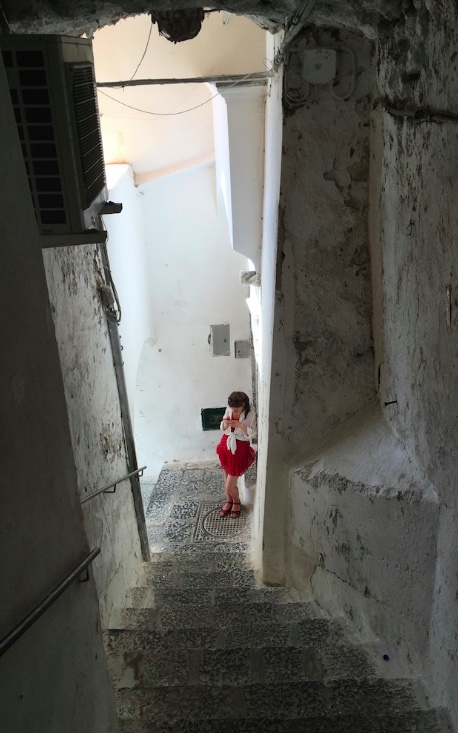Because I live under a rock, I’d never even heard of the Amalfi Coast until Rachel put it on our itinerary. Over the 48 hours of our stay, it climbed onto my Worldwide Top 10 list.
We stayed in Salerno, a medium-sized city on one of the slightly less spectacular stretches of the Amalfi Coast. And it only qualifies as slightly less spectacular because towns like Amalfi (coming soon) and Capri (just Google it) raise the bar unattainably high.
Here’s the part of Salerno we stayed in:
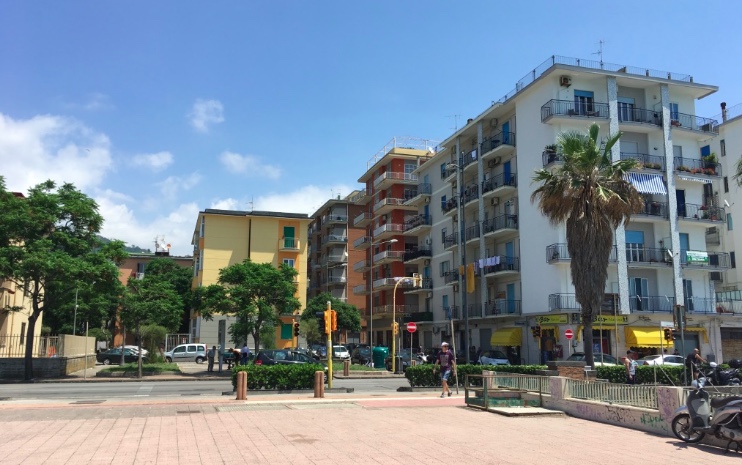
When we checked into the airbnb and our lovely and voluble hostess, Elena, heard that Rachel was learning Italian, she swept through the kitchen pointing to things and giving us the Italian names for them. So in addition to hello, thank you, where is the bathroom?, and assorted foods and coffee drinks, I now know how to say cup, smaller cup, knife, fridge, coffeemaker, and oven mitt. Elena named every utensil in the apartment, but I got information overload.
We did have a few minor translation hiccups. On our first night, according to Elena, spoons were ‘sponges.’ The next morning I asked for a spoon and she gave me a beach towel.
The beach towel was useful anyway:
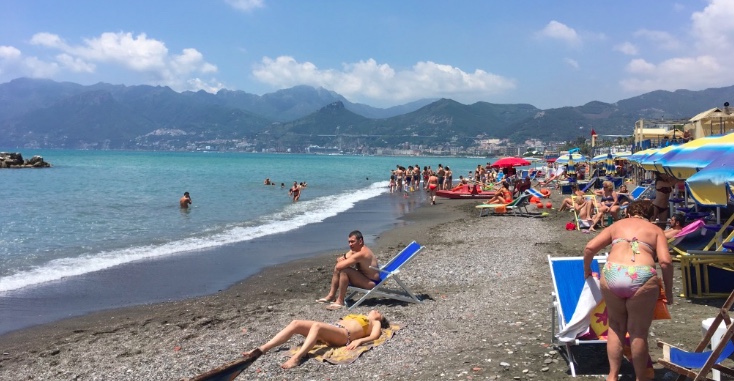
That’s the Tyrrhenian Sea, which is the strip of Mediterranean between Corsica and the west coast of Italy. Sticking my feet in for the first time was particularly resonant for me because the Tyrrhenian is the principle setting of one of my novels, and while I’d done a great deal of research and looked at a whole lot of Google Images, I’d never felt the volcanic sand between my toes. The water is so warm and so blue, you wouldn’t believe.
And now we get to the history geek bit:
When sunburn, hunger and crowds finally drove us off the beach, we wandered into Salerno’s downtown.
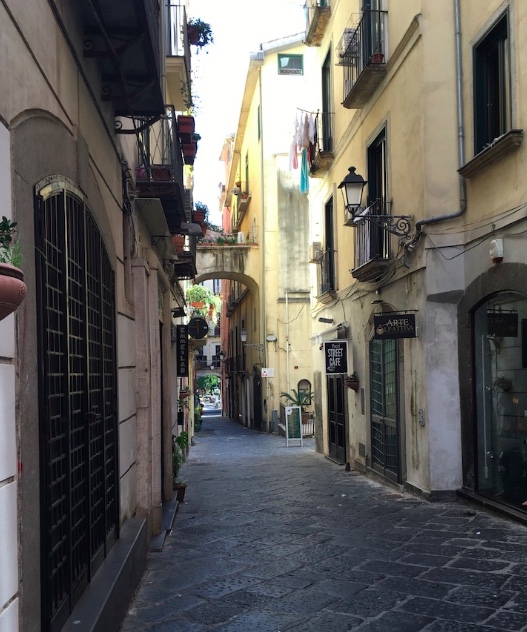
The thing about Salerno’s old quarter, like that of Amalfi or backstreet Rome or parts of Verona, is that the street grid is narrow and twisty and medieval, with cool passages and sloped, meandering alleys and places where the sun probably never reaches the ground, but the buildings look so modern. The windows are big. The stucco is new. You think you’re looking at an apartment from the 1940s, till you realize there’s the capital from a Corinthian column embedded in the doorframe.
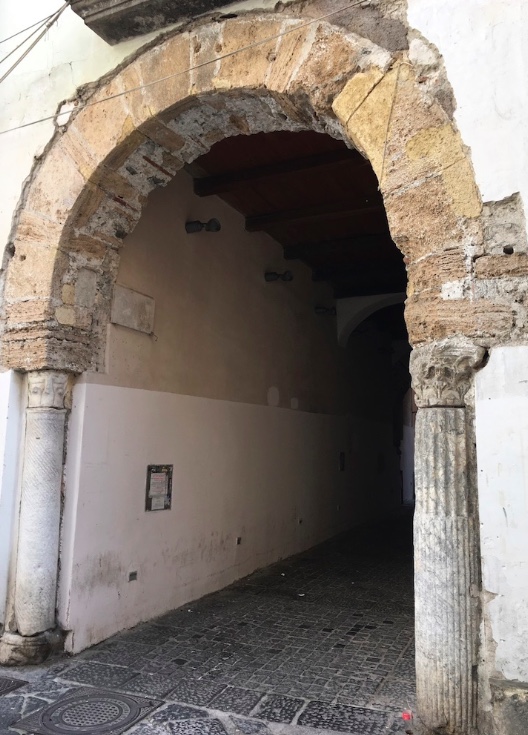
We wandered into cheap boutiques with barrel-vaulted ceilings and no windows. One had a glass cutout in the floor, so scuffed that you couldn’t see through it except if you crouched at its edge, at which point you’d realize you were looking down a wide, deep well that probably hasn’t seen sunlight in a thousand years.
I’ve never managed to find the architectural term for these places where the street cuts through a covered passageway in the base of a building. The internet is flummoxed. If any of my readers know what these are called, please comment it so I can sound more intelligent next time I wax poetic about a historic old town! Because something about these passages captures the echoes of history better than nearly anything else; standing beneath one, you can nearly hear the rumble of thousand-year-old cart wheels.
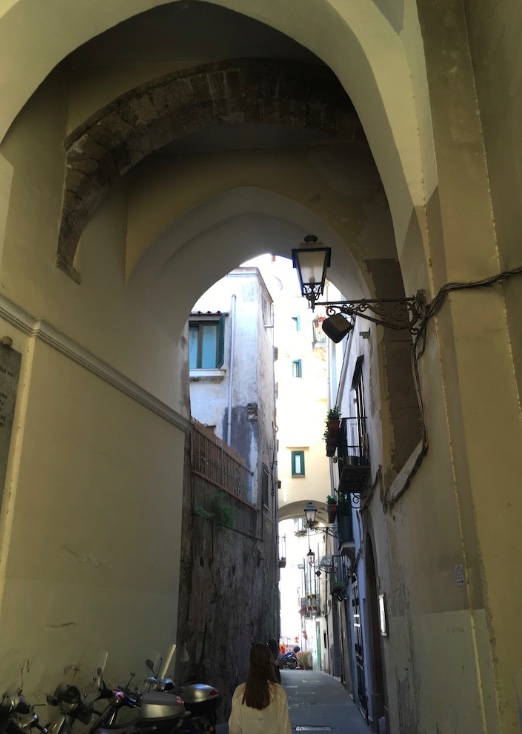
The streets always seem too narrow for the sheer size of some of the old palazzos:

Possibly because I’ve been living in the UK, where the combined effects of a damp climate, Victorian tampering and the Industrial Revolution ensure that almost nothing survives from before the Norman Conquest of 1066, I was blown away by the age of Salerno. This is a city that peaked in the 8th and 9th centuries A.D.
From its origins as the Etruscan city of Irna in the 6th century BC, Salerno passed through Samnite, Syracusan, Roman and Byzantine ownership before eventually landing in the hands of the invading Lombards in the 7th century A.D. And if none of those names mean anything to you, rest assured that I had to Google the Samnites, too.
Salerno peaked under the Lombards, who made it the seat of the Duchy of Benevento as they attempted to secure the region against the invading Charlemagne (that name, at least, you probably know). But less than a century later, Salerno declared its independence, ousted its Benevento rulers, and became a regional capital in its own right. Its rulers (Wikipedia isn’t clear on who these were at this point, but one of them had the beautifully archaic name Guaimar) harbored ambitions to unite the whole of Southern Italy under Salerno’s coat of arms.
The city was at this point flourishing as the cultural and economic center of the Principality of Salerno, which encompassed much of modern Campania. Its coinage circulated the whole Mediterranean. It was home to the first medical school in Western Europe.
But in the 11th century, weakened by plague, Saracen attacks and infighting, Salerno lost most of its lands to the Normans and fell into decline.
At which point we move out of my area of historical interest. I think Dad put the Battle of Salerno and my great-grandfather in the same sentence, but since the words “World War II” trigger my zone-out reflex, I’m going to have to follow up.
Here’s another of those lovely covered passageways with Rachel at the bottom:
